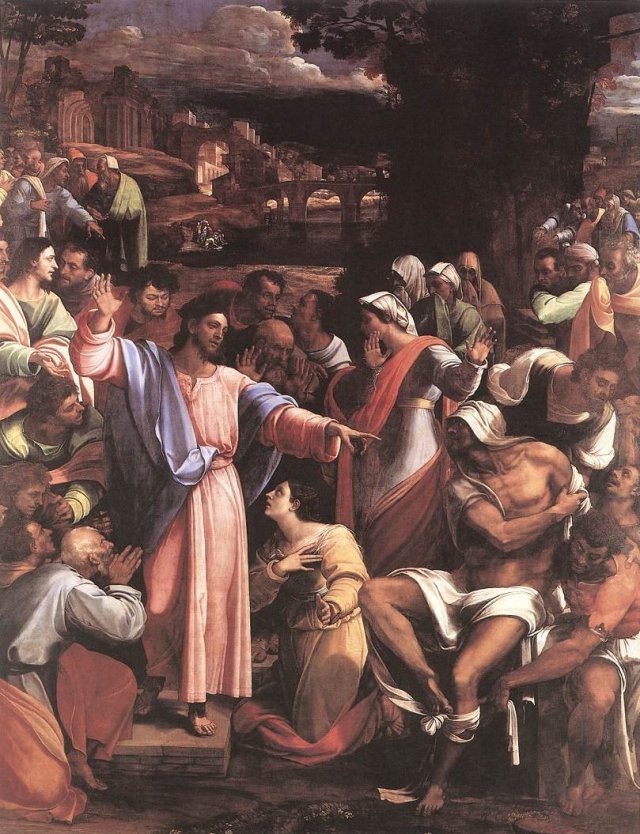The Raising of Lazarus
The Raising of Lazarus
Sebastiano del Piombo 1519
Sebastiano completed the painting in January 1519 and it was
immediately hailed as an artistic triumph. Michelangelo Buonarroti
befriended Sebastiano, and he became one of the rare and trusted friends of Michelangelo.
The friendship, however, drew Sebastiano into the long running rivalry between
Raphael Sanzio.
Cardinal Guilio de’Medici had commissioned Raphael to create
a large altarpiece depicting “Christ’s Transfiguration” for the cathedral in Narbonne .
The Cardinal also commissioned Sebastiano to create “The Raising of Lazarus” as
a large altarpiece for Narbonne ’s
cathedral. It wasn’t out of the ordinary to commission two paintings for the
same cathedral, but many believe today – and in the 1500s – that the cardinal
was pitting the two artists against each other. The Cardinal, of course, was
well aware of the artistic rivalry between Michelangelo and Raphael.
Michelangelo was very willing to lend Sebastiano a hand with the work by
supplying him with sketches that could be incorporated into “The Raising of
Lazarus.”
You can read about Jesus raising Lazarus from the dead in
John 11. A portion of these verses are used in our Lutheran churches this
Sunday for the Gospel lesson for the 5th Sunday in Lent.
Sebastiano’s painting depicts specifically verses 40-44: “Then Jesus said, Did I not tell you that if you
believed, you would see the glory of God?’ So they took away the
stone. Then Jesus looked up and said, ‘Father, I thank you that you have heard
me. I knew that you always hear me, but I said this for the benefit
of the people standing here, that they may believe that you sent me.’ When he
had said this, Jesus called in a loud voice, ‘Lazarus, come out!’ The
dead man came out, his hands and feet wrapped with strips of linen, and a cloth
around his face. Jesus said to them, ‘Take off the grave clothes and let him
go.’”
In the painting, Christ is standing in the foreground. He is
pointing toward the seated figure of Lazarus, who is still partly covered by his
burial shroud. As the Word made flesh, there is power in Jesus’ words. It is
that Word that created life in Adam, calling him out of the dust of the ground.
It is that same Word that now creates life in Lazarus, calling him out of the
grave before he can become the dust of the ground.
Lazarus is portrayed by Sebastiano as a strong, mature man.
You can definitely see the influence of Michelangelo in Lazarus.
All around Jesus are men and women. Mary, Martha and, their
brother, Lazarus, were popular people in small town of Bethany .
Many, no doubt, also traveled from Jerusalem ,
which only two miles away from Bethany .
On the left, mid-ground, there is a group of Pharisees who
are unimpressed with what they have seen. They demanded miraculous signs from Jesus,
but then immediately discounted them. They are still hell-bent on plotting the
death of the so-called miracle worker.
While the Pharisees refuse to believe what they see, many
others who are gathered at the tomb are holding up their hands in shock in
disbelief at seeing the previously dead Lazarus coming back to life. Others
talk together discussing what they see before them. There is an old
man on the lower left, hands clasped in prayer as he looks up at Jesus.
Mary is on her knees to the right of Jesus, her hand placed
over her heart. She had once sat at Jesus’ feet listening to Him teach her in
her home. Now she has returned to the ground before the Lord, approaching Him
in faith.
Martha is dressed in a blue robe with a red sash and stands
to the right of Jesus. She has her hands up and her head turned away. She is
recoiling from the sight and smell of Lazarus, for he has been dead for four
days.
As
you meditate upon this painting, also meditate upon the question that Jesus
poses to Martha. As you see Lazarus alive after being buried for four days, do
you believe that Jesus has power over death – your death, Lazarus’ death, His
own death? “I am the
resurrection and the life. He who believes in me will live, even though he
dies; and whoever lives and believes in me will never die. Do you believe
this?”

Comments
Post a Comment